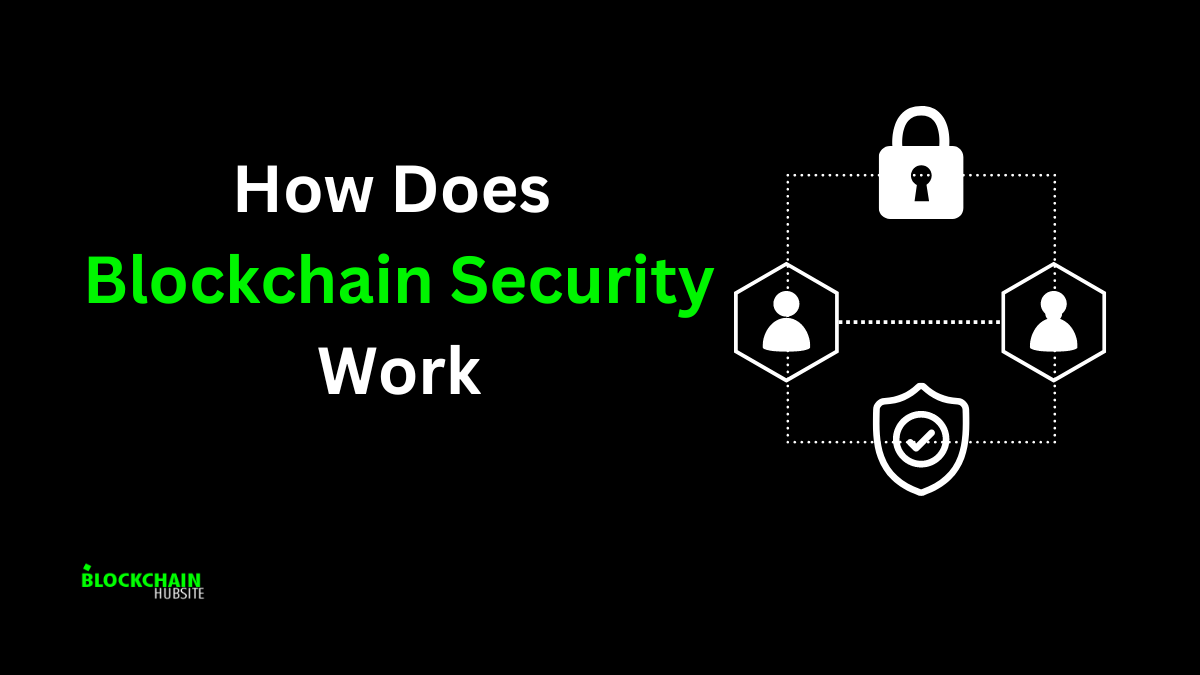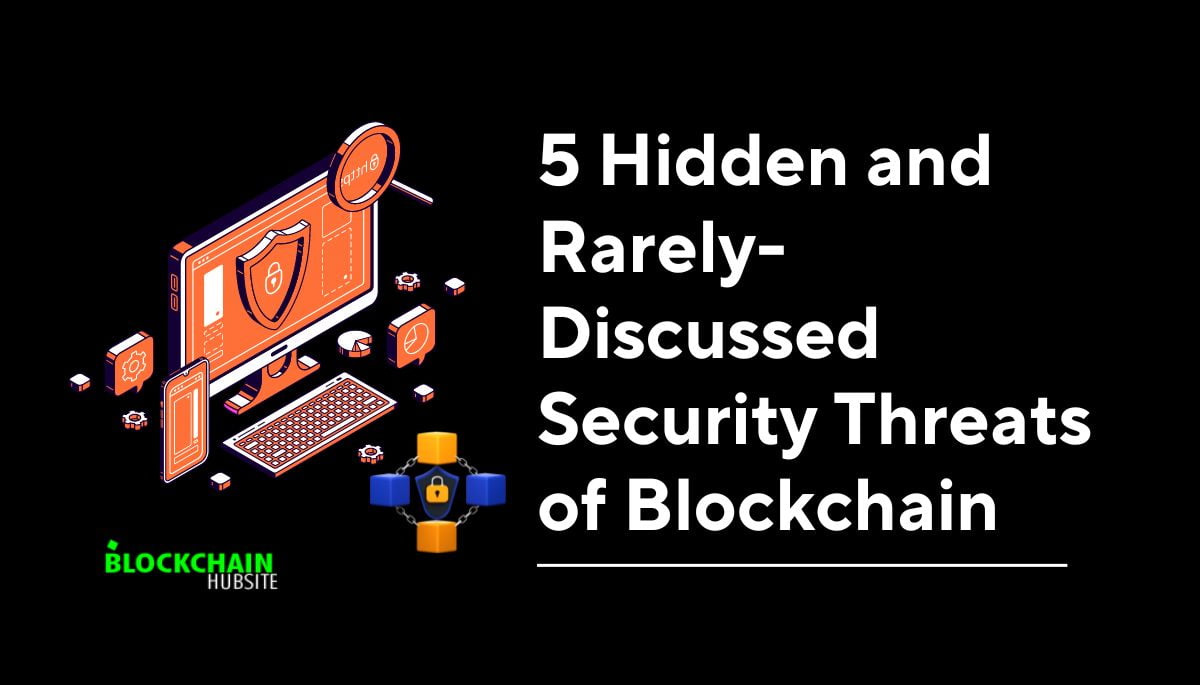
Table of Contents
We live in a technologically advanced era where everyone is provided with technology, so the safety of our data has become a top priority. Security becomes the most profound concern, particularly when we talk about blockchain security, an open network, point-to-point distributed ledger system.
Therefore in this blog post, we’ll explore blockchain security and how it works. We shall understand both its theoretical and practical aspects here.

What is Blockchain Security?
Blockchain security refers to the steps taken to protect and secure a blockchain network and its data. Security includes protecting against hacking and unauthorized access and ensuring the immutability and integrity of the data stored on the blockchain.
Blockchain security depends on a combination of cryptographic techniques and consensus mechanisms to ensure that only authorized parties can access and change the data stored on the blockchain. Blockchain networks are typically decentralized, so by distributing the data and power among a network of users, an additional layer of security is added.
In short, blockchain security is a complete risk assessment process carried out to guarantee the security of a blockchain system or network. Cybersecurity frameworks, security testing procedures, and secure coding techniques are implemented to safeguard a blockchain system from online fraud, breaches, and other cyberattacks.
How does Blockchain ensure security?

Through various fundamental mechanisms, blockchain technology ensures security:
- Blockchain includes a chain of blocks that serve as a ledger of transactions. Every block is connected to the block before it and the blocks afterward. Therefore it is almost impossible for someone to tamper with a single record. It’s all because, to avoid being detected, an attacker would need to alter a chain of blocks.
- Blockchain records are secured using cryptography. In addition, each network member carries the private key assigned to them because of the transactions they have performed. These keys serve as personal digital signatures. This digital signature will no longer be valid if any record is altered, and the peer network will detect a problem.
- Blockchain networks use a consensus method, such as proof-of-work, to verify that all transactions are valid and that the data is correct. In this way, not only can cheating be prevented, but the network integrity can also be maintained.
- Blockchain’s decentralized nature increases its level of security significantly. For example, it is distributed throughout peer-to-peer networks as they are regularly updated, so they remain in sync. There is no single point of failure or control since there is no connection to a central place. This means that to change the blockchain, considerable computational power or, at the very least, control over 51% of it is needed. Thus we can say blockchains are highly resistant to fraud and tampering.
- Smart contracts are self-executing contracts with the agreement’s conditions written directly into the code. The contract automatically comes into effect whenever the requirements are satisfied, assuring the parties that the terms will be fulfilled.
Common Blockchain Security Issues

Even though blockchain security is remarkable, the possibility of a breach still exists. The most common threats to blockchain security are as follows:
51% Attacks

The entire blockchain could be taken over if a group of hackers can take control of a significant proportion (at least 51 percent) of the network’s computing power. This is the theoretically most likely way a blockchain might be attacked and is known as a 51% attack.
However, a 51% attack is challenging to plan for many reasons. Ethereum has more than 2,000 nodes, while Bitcoin has more than 15,000 nodes (computers) running on its blockchain. A 51% attack is costly and impracticable because of the enormous amount of resources required to control half of either network.
The fact that Bitcoin and Ethereum profit from a strong network cannot be ignored. It is more susceptible to attacks because it costs less to hack a minor blockchain with fewer nodes. Some well-known blockchains like Bitcoin SV, Ethereum Classic, Bitcoin Gold, Verge, and Vertcoin are some notable blockchains that have been the victim of 51% of attacks in the past.
Due to the fewer members, private blockchains have a more considerable security risk than other private blockchains. Although controlled access enhances security, still a blockchain can be readily taken over by an insider threat. This is a critical factor for businesses considering adopting private blockchains for business-level transactions.
Distributed Denial-of-Service (DDoS) Attacks

By spamming a blockchain network with transactions, attackers might cause a distributed denial-of-service attack. Most blockchain networks have a fixed transaction limit that must not be surpassed. Otherwise, it will crash.
Despite the common belief, DDoS attacks cannot affect blockchain networks. Solana is a perfect example of malicious actors using a DDoS attack to take down a blockchain.
The blockchain network was subjected to a coordinated DDoS attack on September 14, 2021, which saw up to 400,000 transactions per second flood the network. Unconfirmed transactions clogged the network and took the system offline, as the validators could no longer keep up.
Phishing
Like other online systems, blockchain network users may become the target of phishing schemes in which they are tricked into disclosing private keys and other sensitive information.
Wallet Security
An attacker can access a user’s funds kept on the blockchain if their private keys are stolen. This emphasizes the importance of secure wallet storage.
Sybil Attack
In this attack, which is a type of identity fraud, an attacker generates numerous fake identities, or “Sybil nodes,” to take over a network or interfere with its operation.
Blockchain Censorship
The security and decentralization of the blockchain may be compromised if some governments or organizations attempt to censor specific blockchain transactions or prohibit certain nodes from joining the network.
Replay Attack
A replay attack on a blockchain is when an attacker intercepts a legal transaction and then retransmits it later. Due to this, the transaction is processed multiple times, leading to double-spending of coins or other unwanted effects. Replay attacks can also access funds or other resources or disrupt the network.
Replay attacks are particularly harmful in blockchain networks where multiple transactions use the same private key. An attacker can replay previous transactions and access funds or other resources if a private key is compromised. Networks employ transaction nonce and multi-sig or replay protection mechanisms to prevent replay attacks.
Smart Contract Vulnerabilities

Smart contract vulnerabilities are flaws in a smart contract’s code that an attacker could use to gain unauthorized access to or control of the contract’s features or the assets it controls.
Some examples of smart contract vulnerabilities are:
- Reentrancy: When a contract calls another contract, the second contract changes the first contract’s state before the first contract has finished executing. By continually calling the first contract, an attacker may be able to obtain its assets.
- Unchecked call return values: If a contract doesn’t verify the return value of a call to another contract, an attacker can make a malicious contract that returns a false value and mislead the first contract into transferring assets to the attacker.
- Integral overflow/underflow: These happen when a contract conducts a mathematical operation that pushes an integer value to exceed its higher or lower bound. Unexpected behavior may occur from this, giving an attacker access to the contract’s assets.
- Lack of input validation happens when a contract fails to thoroughly validate the inputs it gets from outside sources, enabling an attacker to pass malicious input that can affect the contract’s functionality.
Attacks on Blockchain-Connected Systems

There are few ways to attack a blockchain besides a 51% attack or a DDoS hack. In actuality, most hacks reported in the media aren’t attacks on the blockchain.
The point of contact between the blockchain and the outside world is where hackers commonly exploit flaws. Consider software clients, third-party applications, and other ways to connect with the blockchain.
Some of it examples include:
Hot Wallet Hacks
“Hot wallets,” or Internet-connected storage used to hold cryptocurrencies, have been the subject of many attacks on cryptocurrency exchanges. Exchanges should ideally move assets to “cold wallets,” offline storage systems to secure them. However, this rarely occurs, leaving these accessible assets to prey on experienced crypto thieves.
Stolen Wallet Keys
A user’s private keys could also be stolen and used to transfer assets without that user’s consent. Traditional strategies like phishing have shown surprisingly effective at tricking people into giving over their private keys. This enables malicious individuals complete access to wallets, allowing them to steal cryptocurrency and other valuables.
Smart Contract Code Exploitation
Smart contract flaws could make it possible for hackers to access blockchain-based decentralized applications (dApps). Then Instead of the blockchain itself, the smart contract’s security is questionable in these situations. The recent Wormhole hack is a classic example of how wrong smart contract codes can result in issues.
Best Practices for building secure Blockchain solutions?

- Based on business contracts, establish and implement endorsement agreements.
- Select a secure consensus mechanism against well-known attack methods, such as the Proof-of-Work (PoW) algorithm used for Bitcoin.
- Aside from applying additional security mechanisms to sidechains, hash data, data in transit, cloud storage, and other areas, data minimization is a general best practice for deciding what data is stored on-chain.
- Controls for identity and access management (IAM) should be enabled to manage blockchain data access.
- Use the appropriate tokens, such as OIDC, SAML2, and OAUTH, to execute user authentication, verification, and authorization.
- Store identity keys safely.
- To safeguard blockchain ledger entries after implementing the appropriate business logic, use a privileged access management (PAM) system.
- API security best practices can be used to protect API-based transactions.
- To protect data or user information, adopt a data classification strategy.
- For sensitive data, use privacy-preserving technology.
- For both internal and external connections, use conventional TLS.
- Use multiple-factor authentication.
- Continue using secure cryptographic key management.
- Use security incident and event management and the hardware security module (HSM) (SIEM).
- Conduct regular vulnerability assessments and penetration tests (VAPT)
- Close security flaws in blockchain-based applications to guard against vulnerabilities and data breaches.
- Before being implemented, a smart contract should be checked for security vulnerabilities.
- Get your Blockchain system certified for security by a reputable organization.
- Monitor the solution’s compliance and other security measures.
What is Blockchain penetration testing?

Blockchain penetration testing is a procedure for assessing the security of a blockchain-based solution or application. Ethical hackers or security experts carry it out to test their security strength.
Blockchain penetration testing is done to find any possible problems in a blockchain system. Effective blockchain penetration testing involves a few key steps, including functional testing, performance testing, API testing, security testing, integration testing, and more.
The steps often taken to accomplish a project’s blockchain penetration test are as follows:
- Discovery
- Evaluation
- Functional testing
- Reporting
- Remediation
- Certification
How to do Blockchain Penetration Testing?
The conducting of blockchain penetration tests includes the following steps:
Step1. Information Gathering and Threat Modeling
We can evaluate and analyze the functional and business requirements in this step.
This step includes:
- Learning the architecture of the blockchain
- identifying the organization’s weak places for threat entry
- Gathering of information about potential exploits that is publicly available
- Analyze the Smart Contract Business Logic
- defining goals for performing security testing
- creating a complete test strategy
- Checking preparedness for compliance
- Creating a testing environment
- Creating test data
Step2: Testing/Discovery
In this step, we can use the data collected in the first step to perform functional testing on our blockchain to determine its development level compared to best practices and industry requirements.
This step includes:
- Testing API Security
- Blockchain Static and Dynamic Testing
- Blockchain Integrity Assessment
- Functional Testing
- Application Vulnerability Assessment
- Automatic and Manual Blockchain Security Analysis
- Documenting Testing Discoveries
- Network Vulnerability Assessment
Step3: Exploitation
This step aims to use any security bugs or vulnerabilities identified during the Discovery phase. Exploitation is typically done manually to eliminate false positives. The exploitation phase also includes data exfiltration from the target and maintaining perseverance.
This step includes:
- Checking for Security Flaws and Vulnerabilities
- Utilizing Security Vulnerabilities and Weaknesses
- Penetration testing of networks
- Penetration testing of Web Application
- Check for Social Engineering Attacks
- Evaluate and Record Discoveries
What are the Blockchain Security Testing tools?

Several security testing tools are available to assist in identifying potential vulnerabilities. However, because of the blockchain’s unique structure, even the most extensive testing may only sometimes discover problems. Developers and businesses should become familiar with potential attacks and develop prevention techniques.
The best blockchain security testing tools will differ depending on the organization’s demands; therefore, there is no one-size-fits-all answer to this question. However, some of the most popular tools used for blockchain security testing are the following:
- Namp
Nmap is a robust network scanning tool that detects open ports and services. It also has features for detecting weak applications.
- Wireshark
Wireshark is a network analysis tool that can collect network packet data and decode it into readable form. Wireshark can be beneficial for detecting malicious traffic or sensitive data being transferred across a network.
- Burp Suite
Burp Suite is a one-stop shop for web application security testing. It can search websites for vulnerabilities, modify requests and responses, and intercept client-server traffic.
- Metasploit
Metasploit is a tool for exploiting vulnerabilities. It provides an exploit library for many programs and operating systems and a wizard to aid penetration testers in capitalizing on known problems.
- MythX
It is a security analysis API for smart contracts that supports Ethereum, Quorum, Vechain, Roostock, Tron, and other EVM-compatible blockchains.
- Manticore
It is a symbolic execution tool for analyzing smart contracts and binaries.
- SmartCheck
Security analyzer for static smart contracts.
- Solidity security blog
Offers a comprehensive collection of crypto-related hacks, bugs, vulnerabilities, and protective methods.
Concluding Remarks
Blockchains are one of the most secure ways to transmit assets and data. Breaching a blockchain network is nearly impossible when the necessary elements are in position, crypto-economics, and consensus.
Not all blockchains, although, are created equal. The consensus method, crypto-economic architecture, and network size can all impact blockchain security.
FAQs
1. Why is blockchain secure?
Blockchain is secure because it uses several cryptographic methods to ensure the legitimacy of transactions. It also employs a distributed ledger system, storing all transactions in a public ledger and validated by multiple participants. Additionally, blockchain networks use consensus algorithms to validate transactions before they are recorded in the ledger.
2. What are the problems with blockchain security?
The main issues with blockchain technology are scalability, lack of regulation, energy consumption, security issues, transaction speed, lack of awareness and understanding, and software flaws.
3. How to minimize blockchain risks?
Use secure protocols, pick reputed and reliable providers, and make sure that proper authentication is in place to reduce the risks related to blockchain technology. Moreover, when developing blockchain applications, it is important to stay up to date on the latest security updates and patches, along with to use secure coding practices.
4. What are the five elements of security?
The five security elements are availability, confidentiality, integrity, authentication, and authorization. Data availability ensures that data is available when needed, while confidentiality ensures that data is kept secure and private. Integrity also ensures that data is accurate and trustworthy, while authentication confirms people’s identities.
5. Can blockchain encryption be broken?
In theory, breaking a blockchain’s encryption is possible, but it would require a massive amount of computing power and would be extremely difficult to achieve. Most blockchains also make use of advanced cryptographic methods and algorithms that are intended to be practically impenetrable.
6. Does blockchain have privacy issues?
Yes, if blockchain technology is not properly implemented, it has the possibility of creating privacy issues.
7. what are the three mechanisms that help keep blockchain secure?
Blockchain security is maintained by three mechanisms: cryptography, decentralization, and consensus. Cryptography is used to secure data and ensure that it cannot be read by anyone other than the intended recipient. Decentralization helps to ensure that the blockchain is not dependent on a single entity, while consensus ensures that all network participants agree on the data’s integrity.




